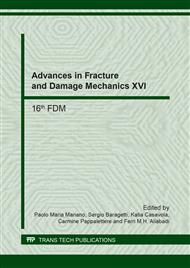p.345
p.349
p.353
p.359
p.363
p.367
p.371
p.375
p.379
Dual Boundary Element Model of 3D Piezoelectric Smart Structures
Abstract:
In this paper, the application of the dual boundary element method (DBEM) in the field of structural health monitoring (SHM) is explored. The model involves a 3D host structure, which is formulated by the DBEM in the Laplace domain, and 3D piezoelectric transducers, whose finite element model is derived from the electro-mechanical behaviour of piezoelectricity. The piezoelectric transducers and the host structure are coupled together via BEM variables. The practicability of this method in active sensing applications is demonstrated through comparisons with established FEM and parametric studies.
Info:
Periodical:
Pages:
363-366
Citation:
Online since:
September 2017
Authors:
Price:
Сopyright:
© 2017 Trans Tech Publications Ltd. All Rights Reserved
Share:
Citation:


